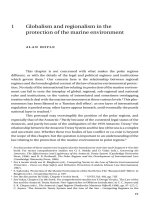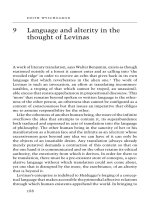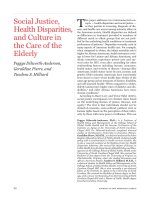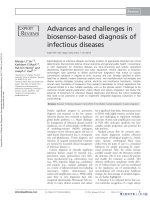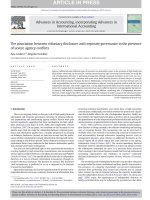Community based health insurance practice enrollment and challenges in ethiopia case of oromiya regional state rural community of aleltu district’’
Bạn đang xem bản rút gọn của tài liệu. Xem và tải ngay bản đầy đủ của tài liệu tại đây (1.56 MB, 129 trang )
ADDIS ABABA UNIVERSITY
COLLEGE OF BUSINESS AND ECONOMICS
SCHOOL OF POST GRADUATE
DEPARTMENT OF PUBLIC ADMINISTRATION AND DEVELOPMENT
MANAGEMENT (PADM)
“COMMUNITY BASED HEALTH INSURANCE
PRACTICE/ENROLLMENT AND CHALLENGES IN ETHIOPIA CASE OF
OROMIYA REGIONAL STATE RURAL COMMUNITY OF ALELTU
DISTRICT’’.
By:
Gutema Namomsa
Advisor:
Bikila Hurisa (Ph. D)
June 2017
Addis Ababa, Ethiopia.
Addis Ababa University
School of Graduate Studies
College of Business and Economics
Department of Public Administration and Development Management
“COMMUNITY-BASED
HEALTH
INSURANCE
PRACTICE/ENROLLMENT
AND
CHALLENGES IN ETHIOPIA CASE OF OROMIYA REGIONAL STATE RURAL
COMMUNITY OF ALELTU DISTRICT’’.
A thesis submitted to the Department of Public Administration and
Development Management of Addis Ababa University in the partial
fulfillment of the requirement for the Masters of the Public Management
and Policy (MPMP).
By:
Gutema Namomsa
Advisor:
Bikila Hurisa (Ph.D)
June 2017
Addis Ababa, Ethiopia.
Addis Ababa University
School of Graduate Studies
College of Business and Economics
Department of Public Administration and Development Management
This is to certify that the thesis prepared by Gutema Namomsa
entitled “Community-Based Health Insurance Practice/Enrollment & Challenges in Ethiopia:
Case of Ormiya Regional State; Rural Community of Aleltu District’’. Which is submitted in
partial fulfillment of the requirements for the Degree of Public Management andPolicy
(MPMP), complies with the regulations of the University and meets the acceptedstandards
with respect to standards to originality and quality?
Approved by Board of Examiners:
___________________
Advisor
_________________
Internal Examiner
____________________
External Examiner
_________________
Signature
________________
Signature
_____________
Signature
______________
Date
______________
Date
_______________
Date
Declaration
I
declare
that
this
Research
Report
on
“Community-based
health
insurance
practice/enrollment & challenges in Ethiopia: case of Oromiya regional state; rural
community of Aleltu district’’. Is my own original work with assistances and guidance from my
Advisor and not submitted before for any institution and any purpose. I further declare that all
the sources used in this research report have been properly recognized and acknowledged as intext-citation and reference list.
Gutema Namomsa Daraje _____________________
________________
Signature
Date
Acknowledgment
First & for most I owe my heartedly thanks to almighty God, the merciful and compassionate, for
helping me to carry the entire burden via my study & research conduct.
My heartfelt gratitude goes to my families (Especially My dad Mr. Namomsa D. Keba&
My
Mam Kebebush Bayisa as well as my sisters Alganesh, Aster & Mimi) for their infinite support
in my study journey).
My especial thanks go to my thesis advisor Bikila Hurisa (Ph. D) whose kind support, insight &
guidance have turned the whole process of this study endeavor full of learning and enjoyable.
I would also like to thank to the employees and management of EHIA & district office who
cooperate with me by filling honest interview that provide valuable information for conducting
& completing this study.
Finally, yet important, special thanks go to Mr Demise (CBHI Finfine branch manager) Mr
Kidane Irana (Team leader of Aleltu CBHI).
i
Dedication
I would like to dedicate this thesis to my grandfather Mr. Bayisa Bekere. His role in my life
(especially) in my academic life is very significant. I can’t express his role within one page of
paper, I know my grandfather ‘’Akakeyu’’ without your constructive advice I will not reach this
stage your special model. So my lovably grandfather when I decide to dedicate my thesis work to
you it is without any doubt hence I love you & RIP.
Ermiyas Namomsa.
ii
Table of content
Page
Acknowledgment ............................................................................................................................. i
Dedication....................................................................................................................................... ii
Table of content ............................................................................................................................. iii
List of table ................................................................................................................................... vi
List of Figure.................................................................................................................................. vi
Acronyms........................................................................................................................................ x
Abstract .......................................................................................................................................... xi
CHAPTER ONE ............................................................................................................................. 1
1.INTRODUCTION & BACKGROUD OF THE STUDY............................................................ 1
1.1.Introduction ........................................................................................................................... 1
1.1.1.Ethiopian Health Insurance Agency ............................................................................... 2
1.2.Statement Of The problem .................................................................................................... 3
1.3.Objectives of The study......................................................................................................... 6
1.3.1.General research Objectives ........................................................................................... 6
1.3.2.Specific research Objectives........................................................................................... 6
1.4.Research question.................................................................................................................. 6
1.5.Significance of the study....................................................................................................... 7
1.6.Scope of the Study................................................................................................................. 7
1.7.Limitation of the study .......................................................................................................... 8
2.Literature Review......................................................................................................................... 9
2.1. Concept of Community Based Health Insurance ................................................................. 9
2.2 Weakens of Community Based Insurance. ......................................................................... 12
2.3 Types of Community Based Health Insurance.................................................................... 12
iii
2.3.1. Community prepayment health organizations ............................................................. 15
2.3.2 Provider based health insurance schemes..................................................................... 15
2.3.3. Government runs community-involved health insurance............................................ 15
2.4. Community Based Health Insurance in Developing country............................................. 16
2.5 Community Participation .................................................................................................... 19
2.6 Empirical findings concerning the performance/enrollment of CHIs ................................. 20
2.6.1 Performance criteria ..................................................................................................... 20
2.6.2. Exploring factors that influence performance ............................................................. 21
2.6.2.1 Factors influencing membership............................................................................ 21
2.7. Health Sector in Ethiopia ................................................................................................... 23
2.7.1 Community Based Health Insurance in Ethiopia ......................................................... 25
2.7.1.1. Knowledge, Enrollment, and Affordability .......................................................... 29
2.7.1.2. Major Challenges in quality services provided..................................................... 30
2.7.1.3 Mobilizing Additional Resources to Health Providers .......................................... 30
2.7.1.4. Remove Overall Health Systems Constraints ....................................................... 32
2.7.2. Enrollment & significance of CBHI in Ethiopia ......................................................... 32
3.Research Methodology & Methods ........................................................................................... 39
3.1. Research Design................................................................................................................. 39
3.2 Study & sample population ................................................................................................. 40
3.3 Sample Design..................................................................................................................... 40
3.3.1 Sample & Sample size determination........................................................................... 40
3.3.2 Sampling Techniques ................................................................................................... 41
3.4 Types of data and data collection Technique ...................................................................... 42
3.4.1 Types of data ................................................................................................................ 42
3.4. 2 Primary data collection Technique .............................................................................. 42
iv
3.5 Secondary data collection Method ...................................................................................... 43
3.5.1 Data Analysis Methods................................................................................................. 43
3.6 Data Presentation Modality................................................................................................. 44
3.7 Ethical Consideration .......................................................................................................... 44
4. Data Presentation and Analysis ................................................................................................ 46
4.1 Introduction............................................................................................................................. 46
4.2 Background of the respondents ........................................................................................... 46
4.3. Beneficiaries (insured household‟s) response on CBHI .................................................... 53
4.3.1 Awareness level of Community on the concept of Community based health insurance
........................................................................................................................................ 53
4.3.2. Households health status & income impact on the CBHI ........................................... 62
4.3.3. CBH, its challenges & benefits.................................................................................... 66
4.3.4. Participation in CBHI programs .................................................................................. 84
4.4 Discussion of the result ....................................................................................................... 87
4.4.1 Practice/enrollment of Community based health insurance ......................................... 87
4.4.2 Challenges faced on enrolling the Community based health insurance ....................... 88
4.4.3 Major benefit the society is getting from enrolling in CBHI ....................................... 89
5. Conclusion & Recommendation ............................................................................................... 90
5.1. Introduction ........................................................................................................................ 90
5.2 Conclusion........................................................................................................................... 90
5.3 Recommendation................................................................................................................. 92
Bibliography ................................................................................................................................. 94
Annexes......................................................................................................................................... 96
v
List of table
Page
Table 2.1: Features of different CBHI models……………………………………………….13
Table 2.2: List of pilot and control woreda‟s…………………………………………………..27
Table 2.3 Projected Annual Financial Implications of CBHI Scale-up to
Federal, Regional, and Woreda Governments ('000 Birr)……………………………….31
Table 2.4 Major Parameters of Ethiopian CBHI Pilot Schemes…………………………………34
Table 3.1 shows the population & sample selection of the study………………………………42
Table 3.2 Profile of the officials (employees)…………………………………………………42
Table 4.1: Beneficiaries Age related distribution………………………………………….……47
Table 4.2: Martial status of the respondents……………………………………………....….49
Table 4.3: Occupational status of the respondents……………………………………….….51
Table 4.4: Number of children‟s >=18 &<18 years old………………………………….……..53
Table 4.5: Response on: Do you know Community based health insurance……………….54
Table 4.6: Response on: Do you attend any local meeting on detail of how scheme
work CBHI?.......................................................................................................................55
Table 4.7: Response on: Enrolling in community based health insurance has advantage ….58
Table 4.8: Response to: Level of knowledge & understanding on the CBHI…………………..61
Table 4.9: Response on: Products you produced……………………………………………….64
vi
Table 4.10: Response on: when you started enrolling in CBHI………………………………..67
Table 4.11: Response on: Our health status is improved after enrolling in CBHI………………70
Table 4.12: Response on: Do you renew your membership ID timely………………………….73
Table 4.13 Responses on: I haven‟t get any advantage in enrolling in CBHI…………………74
Table 4.14: Response on: I decided to resign my membership from CBHI…………………75
Table 4.15: Response on: Am happy with Current premium & timing of collecting…………79
Table 4.16: Response on: The nearest conventional health institution to you………………83
Table 4.17: Are you getting medicines prescribed to you timely (especially very essential….84
vii
List of Figure
Page
Fig: 2.1socioeconomic inequalities in health service coverage………………………………..25
Fig: 2.2 Enrollment rate (%) and indigent HHs registered as members, June 2013…….…....37
Figure 2.3 Regional Enrollment Rate and % of HHs Registered as Indigents, June 2013….…..37
Figure 2.4 Framework of analysis………………………………………………………….…..38
Figure 2.5: Own conceptual frame work……………………………………………………….38
Fig: 3.1 the study area of the research …………………………………………………………..45
Fig 4.1: Gender of the respondents & its distribution……………………………………………47
Fig 4.2 realtion of the respondents to household………………………………………………48
Fig 4.3 Martial status of the respondents………………………………………………………49
Fig: 4.4 Educational status of the respondents & its distribution………………………………50
Fig: 4.5 Family sizes of the respondents…………………………………………………………52
Fig 4.6 Do you attend any local meeting on detail of how the scheme work…………………55
Fig: 4.7 from whom/what you heard about CBHI……………………………………………..57
Fig: 4.8 Have you started getting health service via your insurance…………………………60
Fig: 4.9 Level of knowledge on CBHI ……………………………………………………….…61
Fig: 4.10 how do you rate the health status of your family?..........................................................63
Fig: 4.11 Number of wild-animals that households have……………………………….……65
viii
Fig: 4.12 before enrolling in CBHI how you covered you medical expense……………………68
Fig: 4.13 Type of membership…………………………………………………………………72
Fig: 4.14 Challenges in CBHI drugs)……………………………………………………….….76
Fig: 4.15 how is health facility utilization in health institution you are getting service
via CBHI? ………………………………………………………………………….…81
Fig: 4.16 have you get opportunity to discuss with responsible body from the
Woreda/ federal health insurance agency?........................................................................85
Fig: 4.17 Do you have enough participation on CBHI than paying the
premium for your membership…………………………………………………….…..86
ix
Acronyms
CBHI: Community Based Health Insurance.
EHIA: Ethiopian Health Insurance Agency.
WHO: World Health Organization.
SSA:
Sub-Saharan Africa
LMICs: Low-income and middle-income countries.
SHI:
Social Health Insurance.
EMOH: Ethiopian Minister of Health.
SNNP: Southern Nations, Nationalities, and Peoples.
UHC:
Universal Health Coverage.
HEP: Health Extension Program
PHC:
Primary health care
PHCU: Primary Health Care Units
USAID: The United States Agency for International Development
MDG: Millennium Development Goals
HSDP: Health Sector Development Program
HSFR/HFG: financed Health Sector Financing Reform/Health Finance and Governance
OOP: Out of pocket payment
PFSA: Pharmaceutical Fund and Supply Agency
x
Abstract
This study examines the Community based health insurance Enrollment/practice & challenges in
Ethiopia by taking Aleltu district as case of study. The study, with the prime objectives of to find
out & mention the roots of problems & was geared towards answering key research questions
germane in enrollment of the CBHI in the Aleltu woreda.
Primary data have been collected from beneficiary’s (members) of CBHI by taking 150
respondents from five Gandas namely Maru, Mikawa, S/sageda, Ejersa & W/dera using
structured self-administer questioner. Three employees of CBHI were contacted for in-depth
interview & one manager of CBHI Finfine branch also has been contacted for triangulation
purpose. The data were putted in SPSS version 21 in order to get descriptive statistics or result.
The Qualitative data collected via in-depth interviews & open ended questions were analyzed
through transcription in to micro-soft word processing then by categorizing & coding on their
theme.
The result, of the analysis shows that supply side challenges such as Lack of skilled man power
in handling the CBHI in the woreda, Lack of budget to perform the enrollment rate of CBHI in
different villages of Aleltu, Absence of available nearest government hospitals at the distract
level, lack of enough man power because, Absence of digital camera in order to take the photo of
households during their membership, Absence of enough computers & printers (In order to
encoding the file of each members), the office is not covenant (narrow in size), the government
health service is not satisfactory like the private health sectors therefore peoples prefer to a
place where good service is provided. Among demand side challenges; during registration time
households will not bring required things (For instance Photo graphs, filling of necessary
data’s), during the claim of money paying during the refer time they will forget the receipt for
the payment they made at the referral hospitals, During the filling of ID membership they will
not tell necessary information, dalliance on Id renewal, during registration time they will not
bring their family member.
Key Words: CBHI, Enrolment, Challenges, Aleltu District & Northern Shoa Zone
xi
CHAPTER ONE
1. INTRODUCTION & BACKGROUD OF THE STUDY
1.1.Introduction
Hundred million people every year are driven into poverty due to catastrophic health expenditure
across the world. It is imaginable that most reside in resource poor settings such as SSA with
very weak modern health care systems and in most cases without any functioning health
insurance schemes,(Guy, 2003).
The result is high disease burden as well as a high risky propagating sickness and being absent
from productive works. In Sub-Saharan Africa, formal and well-functioning health insurance
scheme generally exist for few people who are employed in formal sectors. For the majority,
health care is accessed and/or covered from own source of money which is mostly sourced from
existing funds or assets, this mostly leads to least use of health care services,(ibid).
If CBHI schemes are to serve as a means to providing access to health services, at least in the
short term, then attention should be paid to the issues that militate against their success.
Community Based Health Insurance Schemes (CBHISs) are promising alternatives for a cost
sharing health care system which hopefully also leads to better utilization of health care services,
reduce illness related income shocks and eventually lead to a sustainable and fully functioning
universal health care system. The source of finance used to supplement the Health sector in
Ethiopia are from government sources, out of pocket payments at the time of service, from
external donors and charity activities, as well as from insurance sources,(WHO, 2005).
More than 80% of total private health expenditure in Ethiopia is in the form of out-of-pocket
payments, revealing an inefficient, inequitable structure of private health expenditure. It is hoped
that insurance will help stabilize the government‟s health budget, and make financing more
efficient and equitable, thereby bolstering the country‟s Health Sector Development Program.
(MLI, 2013)
1
Based on the 2007 national health account around 7.14 USD were spending per person.
Compared to the world health organization standard which estimated around 34 USD per person
per annum is much higher than the national health accounts. Thus spending for health
expenditure were so low and the expenditure were accounted from different sections and sectors
accordingly around 31% from government, 37 % from donor/development organizations and
directly from user fees are 30%,(FMOH, 2009).
From this we can understand that a payment rate that is paid directly by users at the time of
service is unaffordable, especially for the poorest of the poor (indigent) which also inhibits
beneficiaries from visiting health facilities.
At different time the government of Ethiopia has been taking different reform‟s among them
health sector reform is a part of it. Currently, the government is introducing various tools to
finance health sector programs among them CBHI is for the informal sectors & those lead their
lives on agricultural sectors where as SHI involves formal/employed sector of the economy, once
policies are issued premium collection would be directly deducted from salary of beneficiaries.
Both are insurance types what differs is the premium collection methods, the type of participants
that involve and largely in case of CBHI continuous and rigorous awareness creation and
behavioral change activities are highly demanded,(EHIA, 2015).
1.1.1. Ethiopian Health Insurance Agency
Ethiopian Health Insurance Agency (EHIA) is a federal government agency established as an
Agency in 2010 with regulation No.191/2010. With the responsibilities of: establish and
implement efficient and effective health insurance system, Collect and administer monthly
contributions of the social health insurance system, Undertake public education and sensitization
on health insurance, (EHIA, 2015)
1.1.1.1 Mission of the Agency
The primary mission of this EHIA is to provide quality and sustainable universal health care
coverage, (ibid).
2
1.2.Statement Of The problem
The catastrophic nature of health care financing mechanism for the poor and often rural
population has been a source of concern in African Countries. According to WHO; one hundred
fifty million people globally suffer financial catastrophic shock each year, and one hundred
million are Pushed into poverty because of direct payments for health services. Communitybased health insurance schemes are becoming increasingly recognized as an instrument to
finance health care in developing countries, with certain weaknesses such as low capital start up
base, small size of risk pool, lower level of revenue mobilization, limited management capacity,
and isolation from more complete benefits. (Adane K. et al , 2013)
Both supply and demand side constraints contribute to the low health care utilization of Ethiopia.
In 2009, the number of hospital beds per 10,000 people was 2 (while the average availability for
SSA region was 9), the number of nurses and midwives per 10,000 populations was 2 (11 for
SSA) and that of physicians (generalist and specialist medical practitioners) was only 0.4 (2 for
SSA), (WHO, 2010).
Poor health care financing remains a major challenge for the health system of Ethiopia. It leaves
households vulnerable to impoverishment from catastrophic health expenditures, and slows
progress towards health improvements such as the Millennium Development Goals by limiting
access to essential health services among the poor. Important barriers to improved health care
financing include: low government spending on the health sector, Strong reliance on out of
pocket expenditure, inefficient and inequitable utilization of resources, poorly harmonized and
unpredictable donor funding , (ibid, 2010).
As different studies showed that in developing countries the majority of the people from poor
families cover costs for health care out of pocket. As a result many fell into debt which aggravate
sever poverty conditions.
Study that conducted by Adebayo et al. (2015)support the above truth in LMICs, while CBHI
schemes may be helpful in the short term to address the issue of improving the rural population
and informal workers‟ access to health services, they still face challenges: Lack of funds, poor
quality of care, and lack of trust are major reasons for low CBHI coverage in LMICs.
3
Haile (2014)Conduct research on Willingness to join community based health insurance among
rural households of Debub Bench District, Bench Maji Zone, South west Ethiopia. Crosssectional community based study was conducted in Debub Bench District in March 2013 using a
pretested structured questionnaire. About 78% of the respondents were willing to join the
scheme. Most of demographic, socioeconomic variables and social capital were found to be
significantly associated with willingness to join community based health insurance. Finally, the
researcher concluded that if the scheme is initiated in the district, majority of the households will
enroll in the community based health insurance. Therefore initiation of the scheme is beneficial
in the district.
(Adane K. et al , 2013) Studied on Willingness to pay for community based health insurance
among households in the rural community of Fogera District, North West Ethiopia. The study
concludes and recommends that willingness to pay for the Community based health insurance
scheme was encouraging. However, the amount of the premium should consider the family size,
wealth status and the willingness of the households.
Yilma et al(2015)also conducted study on impact of Ethiopia‟s Community Based Health
Insurance on Household Economic Welfare. The findings of the study showed that main benefit
of the scheme is its effect on reducing the need to borrow. This may have longer-term benefits in
reducing vulnerability to other forms of shocks. The combined results provide support to the
government‟s recent move to extend the CBHI pilot to a total of 161 districts for further testing.
However, a nationwide scale up requires an examination of the scheme‟s financial sustainability.
Further Hilina (2014) conducted research on Socio Economic Determinants of Community
Based Health Insurance the Case of Kilte Awelaelo District, Tigray Regional State in the study a
logit regression model was employed to analyze the determinants of household head to enroll in
CBHI scheme.
The result of the analysis shows that human capital variables such as household head age,
education, attend local meeting and participate in PSNP, awareness level regarding the program
have a positive impact that household heads would become members/participants of the scheme
while accessibility to credit negatively influence for their decision.
4
Further, empirically different scholars interested on related title from different countries like:
Nair D.(2015)Conducted research on Determinants of Enrollment in Comprehensive Health
Insurance Scheme and Implementation Challenges: A Study in Kerala, South India.
The study uses a qualitative case study design. The result of the study shows that major demand
side factors traced out through in depth group interviews are: lack of awareness regarding the
benefits of the scheme, outpatient care is excluded, coverage is not enough, provider choice is
limited, not happy with the public health facilities etc. The supply side factors are: delay in
getting funds from government, less incentive, over work load etc. Moral hazards were less
compare to other insurance schemes.Finally, the researcher concludes thatPoor people were
benefited through the scheme, but delay in settling finds. Gender equity is addressed. Real
beneficiaries were not identified and included in the list. So income based equity is questionable.
In the above reviewed study majority of the study conducted (case of Ethiopia) merely during
pilot woreda of CBHI implementation but currently CBHI enrollment in Ethiopia is expanded &
enrolled in its full woreda expansion beyond the first 13 identified pilot woreda‟s since the
challenges encountered on CBHI enrollment before the polit woreda schemes & after may not
the same the other critics can be raised from the methodology they were employed majority of
the researcher‟s employed the quantitative approach specially logit regression model.
Hence, this study would fill the gap that exist in the previous studies conducted on pilot woreda‟s
but this study was conducted after the completion of the first stage of selected pilot woreda‟s or
during the full enrollment moment/scale up of CBHI in Ethiopia across the rest woreda‟s in
addition to the previous pilot woreda‟s via employing mixed research method.
This identified the major challenging problems in enrolling CBHI; it assessed the current
progress/enrollment of CBHI, taking Aleltu as study woreda.
5
1.3.Objectives of The study
1.3.1. General research Objectives
The general objective of this study was: to examine the practice/enrollment & challenges of
CBHI schemes in Aleltu woreda.
1.3.2. Specific research Objectives
Specifically, this study intends:
To investigate challenges encounter on enrolling of CBHI program in both demand side
& supply side problems.
To examine the enrollment status of CBHI in the district.
To identify the household‟s level of knowledge & awareness they have on the concept of
Community based health insurance.
To assess the households participation level on CBHI enrolment
To assess the impact of a households health status, family size & income on enrollment
of CBHI?
To find the way how to overcome the challenges facing the CBHI in Aleltu District.
1.4.Research question
This study is intended to answer the following research questions:
What are demand & supply side challenges faced by the study woreda on enrolling the
CBHI schemes?
What is the enrollment status of CBHI in Aleltu district?
What is level of society‟s knowledge &awareness on CBHI program?
What is the participation level of the households on CBHI enrolment?
What is the impact of household‟s family size (underage), family‟s health status &
income level on enrollment?
What are ways used to overcome the challenges facing the CBHI in Aleltu district.
6
1.5.Significance of the study
As part of its health care financing strategy in general and its health insurance strategy in
particular, the Government of Ethiopia endorsed and launched community-based health
insurance (CBHI) schemes in 13 pilot woreda in Amhara, Oromia, SNNP, and Tigray regions in
2010/11 to provide risk protection mechanisms for those employed in the rural and the informal
sectors. Three years on, the government has decided to scale up CBHI, with schemes in 161
woreda (EHIA, 2015).
Different studies‟ were conducted on CBHI but the researcher viewed that there is gap on the
practice & challenges of the schemes on the implemented Ethiopian pilot woreda‟s hence this
study will fill the gap on this area.
Moreover, the CBHI is new reform in health sectors mainly in achieving UHC expanding highquality health care services that are equitable & accessible to all hence based on the findings the
researcher will forward critical recommendation to sustain the scheme.
1.6.Scope of the Study
This study focused on the health services than other public sector‟s & among different health
reforms it scoped on health insurance reforms which works on universal health coverage.
Commonly there are two schemes of Health insurance schemes those are Community based
health insurance (CBHI) which scoped itself on peoples engaged on informal sectors of the
economy & the second schemes is Social health insurance (SHI) that focuses on citizens
employed in formal sectors of the economy. For the sake of the study this research focused on
CBHI due to it is the only schemes now implemented/come in to action than the SHI. For the
sake of case study area Aleltu woreda was selected due to there is good performance & some
challenges on enrolment.
The District Performance last year is 54% which is the highest as compared with other schemes
woreda (EHIA, 2015).
7
1.7.Limitation of the study
In this study I faced challenges like time constraints, budget constraints &respondents were not
available within the time framed. Even if the researcher faced the above listed challenges I used
different techniques to cope up the problems.
8
Chapter Two
2. Literature Review
Introduction
In this chapter various published & unpublished literatures related with this study title would be
reviewed this helps in order to Place each work in the context of its contribution to understanding
the research problem being studied, describe the relationship of each work to the others under
consideration, & In order to triangulate various theories & ideas models with findings collected
via the questioner & interview in this specific study.
2.1. Concept of Community Based Health Insurance
Health is increasingly being viewed not only as an “end” in itself but also as a crucial “input”
into the development process. Indeed a positive link between health and economic growth is
widely established, particularly for low-income countries. As these countries embrace market
reforms as well as integrate themselves with the world economy, there is a concern about
insulating the poor from any possible adverse consequences. While the role of state is on the
retreat in most economic spheres, in social sectors such as health state‟s role will continue to be
important,(Jutting et al , 2003).
Increased expenditure caused by the need to cope with injury and illness has been identified as
one of the main factors responsible for driving vulnerable households further into
poverty,(WHO, 2000).
Consistent with Tabor, Steven R.(2005)CBHIs are called by many different names, including:
micro-insurance, community health finance organizations, mutual health insurance schemes, prepayment insurance organizations, voluntary informal sector health insurance, mutual health
organizations/ associations, community health finance organizations, and community selffinancing health organizations. There is little to distinguish one from another, except that some
terms are more commonly used in one part of the world than another.
9
